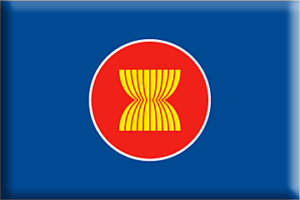FREE ASEAN | DEMOCRACY: Asean needs a Middle Path
.__________________________________________

ASEAN GROUP:
Brunei, Cambodia, Indonesia, Laos,
Malaysia, Myanmar, the Philippines, Singapore, Thailand and Vietnam.
..
__________________________________________
.
Despite the economic downturn during the Covid-19 pandemic, China-sponsored infrastructure, trade and cooperation initiatives with Southeast Asian nations have been moving forward consistently — amplifying the presence of Beijing in one of the world’s fastest growing regions.
__________________________________________
SPACE RESERVE FOR ADVERTISEMENT
__________________________________________
One recent landmark event was the inauguration of the 414-kilometre China-Laos high-speed railway on Dec 3. The $5.9-billion route connects the Lao capital Vientiane with Boten on the Laos-China border, where it is linked to the line heading to Kunming, the capital city of Yunnan province.
Part of China’s vast Belt and Road Initiative, the project is seen as part of a Pan-Asian railway — running from Kunming down to Singapore and crossing strategic cities including Bangkok and Kuala Lumpur — that will propel trade between China and mainland Southeast Asia and beyond.
__________________________________________
SPACE RESERVE FOR ADVERTISEMENT
__________________________________________
In Cambodia, meanwhile, a Chinese-invested expressway linking the capital Phnom Penh to Sihanoukville, a coastal city where a deep seaport and special economic zone are located, is reported more than 70% completed.
And in Indonesia, the construction of the 142-kilometre Jakarta-Bandung high-speed rail line is on track and expected to be finished by the end of this year despite a cost overrun of nearly $2 billion. In Malaysia, work is 25% completed on the East Coast Rail Link, a 665-kilometre line starting at Port Klang on the west coast, crossing the peninsula and running up the east coast to the Thai border. China is funding both projects.
“Everyone in the [Southeast Asia] region is rightly preparing for post-pandemic development,” said Yang Yi, secretary-general of the China Institute of International Studies, a research institute administered by China’s Ministry of Foreign Affairs.
Strengthening the relationship with the Association of Southeast Asian Nations (Asean) has always been China’s priority, Mr Yang said at a webinar on issues arising from the US-China geostrategic rivalry, including management of the Mekong River, held by the Institute of Security and International Studies Thailand (ISIS) last month.
__________________________________________
SPACE RESERVE FOR ADVERTISEMENT
__________________________________________
China’s bilateral trade with Asean grew 38% year-on-year in the first half of 2021, exceeding $410 billion. China has remained Asean’s largest trade partner in the past 12 years. Direct investments from the mainland accounted for 5.7% of overall inflows to Asean over the first 10 months, Mr Yang said.
__________________________________________
SPACE RESERVE FOR ADVERTISEMENT
__________________________________________
Beijing succeeded in pushing the Regional Comprehensive Economic Partnership (RCEP) Agreement into effect on Jan 1, creating the world’s largest free trade area involving the 10 Asean states plus China, Japan, South Korea, Australia and New Zealand. In addition, China has continually provided aid, including vaccines and funding, for Asean nations to fight against the Covid-19 pandemic.
The relationship between China and Asean has been strengthened even more during the pandemic, with Beijing providing aid and market access to help countries deal with resource constraints. This relationship is likely to persist even in the post-pandemic era.
On the other hand, the more substantial presence of China in the region during the pandemic — especially through sponsored infrastructure projects and trade — has put the US on higher alert to the implications of China’s growing influence.
Washington has countered by increasing its presence in the region as the Joe Biden administration began to re-establish ties with Southeast Asian nations — after four years during which the administration of his predecessor, Donald Trump, appeared distracted by other parts of the world.
__________________________________________
SPACE RESERVE FOR ADVERTISEMENT
__________________________________________
“Everyone in the [Southeast Asia] region is rightly preparing for post-pandemic development,” says Yang Yi, secretary-general of the China Institute of International Studies. SUPPLIED
China’s expanding influence has prompted the US to put a greater focus on the region as a vital strategic bloc that Washington would like to enlist in helping curb the growing power of the world’s second largest economy.
Late last year, Secretary of State Antony Blinken made his first Southeast Asian tour with other top US diplomats to deepen the region’s allies with the US while counterbalancing China’s power.
In October, Mr Biden himself joined a virtual meeting for the US-Asean summit and pledged $102 million in funds to expand the US strategic partnership with Asean in terms of economic recovery, climate change, health and education. It was the first time in four years that Washington had engaged at the highest level with Southeast Asia.
Meanwhile, Chinese State Councillor and Foreign Minister Wang Yi made a grand tour of his own last year to boost bilateral ties and cooperation with Asean despite China’s outbound travel restrictions under its zero-Covid policy.
In November, Chinese President Xi Jinping himself chaired a special Asean-China summit to commemorate the 30th anniversary of their relationship. He pledged $1.5 billion to support Asean countries’ fight against Covid and boost economic recovery in the next three years.
“Being locked in the intensity of political competition, the US and China have turned the Indo-Pacific region into a cockpit of international rivalry because of the struggle for global supremacy,” said Jittipat Poonkham, associate professor of international affairs with the Faculty of Political Science at Thammasat University, during the ISIS webinar.
The rivalry is like having “two big elephants in the same room” competing in all dimensions, he said. The main areas of the contest are classified as the “3 Ts” — trade, technology and territorial disputes.
The cutthroat competition has gone into the digital space. The US and China are competing on 5G technology and semiconductors, in which Taiwan is strategically important because of its high-tech capacity in semiconductor manufacturing. Meanwhile, the South China Sea territorial dispute has heightened regional tension and is yet to be resolved.
President Xi has promoted a series of bold economic measures, including the Belt and Road Initiative, the Asian Infrastructure Investment Bank and the Lancang-Mekong cooperation channel, seeking to bypass US-led global institutions and rewrite the global order, Mr Jittipat noted.
“Given the intense signs of US-China rivalry, the prospect of the superpowers’ arms spread is likely to be high across the Taiwan Strait, the South China Sea, as well as perhaps the Lancang-Mekong subregion in the third decade of the 21st century,” he said.
The Lancang-Mekong subregion is home to 326 million people in China and the Mekong countries — Cambodia, Laos, Myanmar, Vietnam and Thailand (CLMVT) — all of which connect through the Mekong River, known as the Lancang in China.
The Mekong is the most important river in Southeast Asia because of its abundant water resources that nurture people’s livelihood and biodiversity.
For the past two decades, river management had become a hotly contested element of the development debate. China completed its first hydropower dam on the upper Mekong in Yunnan province in 1995 and 10 more have followed. Combined, they generate 21,310 megawatts of electricity to power the economy of southern China.
Another 11 dams are constructed or planned on the lower Mekong mainstream. Laos completed the first two of its mainstream dams, Xayaburi and Don Sahong, in 2020 to fulfil its dream of becoming “the battery of Asia”.
Since the dams are commercially operated, local communities living along the river have experienced irregular flows of water that cause unusual floods and drought.
“Blue Mekong” — an odd phenomenon where the dense-sediment brown river turns bright blue — has been observed since 2019. The colour indicates a low level of water and sediment. Many experts have blamed the mainstream Chinese dams for holding water. But Beijing denies this is the cause.
The multitude of challenges in the Mekong has grabbed the attention of the Biden administration, which has used the issues to raise China’s aggressive attempt to control the water and, by extension, influence development in downstream countries.
__________________________________________
SPACE RESERVE FOR ADVERTISEMENT
__________________________________________
In 2020, Washington introduced the Mekong-US Partnership that includes initiatives to promote water governance and data availability. The partnership is seen as a mechanism to rival the China-proposed Lancang-Mekong Cooperation (LMC) forum launched in 2016.
The LMC focuses on seeking ways for participant countries to co-manage the Mekong and share prosperity from sustainable development. But it also relieves the tension between China and the Mekong countries on the upstream hydropower dams.
“The LMC is now in the second phase, while the US is also intensifying the US-Mekong Partnership. This [tension] will become more and more visible,” said Pou Southirak, executive director of the Cambodian Institute for Cooperation and Peace.
“This situation should be a wake-up call. The small countries of the CLMVT must cooperate closely to find suitable ways to deal with big countries with different agendas,” he added.
“They must retain certain autonomy and security in securing an ecological benefit and maintaining long-term sustainability of the mighty Mekong River without relying too much on one or the other.”
He said the Mekong Basin has at least 12 cooperation mechanisms or frameworks in place. But although they have some similarities in terms of infrastructure strategy, human resources, development, and poverty reduction, they work independently and are not very well integrated because of different donors’ agendas.
“Any critical issues related to the Mekong subregion should be on the list of top priority of Asean,” said Pou Southirak, adding that the US-China geopolitical rivalry in the Mekong doesn’t get enough attention from Asean nations, “which tend to focus more on the South China Sea conflict”.
__________________________________________
SPACE RESERVE FOR ADVERTISEMENT
__________________________________________
“If the regional grouping does not do more to contribute to the development of the Mekong subregion, in my view, Asean will lose its relevance in all aspects of their external power engagement and therefore seemingly invisible,” he said. “The existing split between the mainland and maritime Southeast Asia will become uncontrollable in the future.”
Water diplomacy is another area where superpower rivalry is evident, fuelled by the decades of inadequate water data in the public domain and a lack of shared decision-making on Mekong water management. This has led to low trust among countries associated with the river and left a gap for the international geopolitical rivalry to fill.
The revival of the Mekong-US Partnership brought the launch of the Mekong Dam Monitor in December 2020, an online platform that provides near-real-time water data modelling from remote sensing, satellite imagery, and GIS analysis. It is partly funded by the partnership and run by a non-profit think tank, the Stimson Center, based in Washington, DC.
Though the data shows the threat to the Mekong River from mainstream dams, it is often used by experts to pinpoint China as a culprit holding upstream water and harming the lower mainstream countries.
On the other hand, in 2020, China agreed to share its year-round water data with the Mekong River Commission (MRC), an inter-governmental organisation formed by the five Mekong countries to manage the river jointly.
But greater availability of water data sources raises concerns about increasing politicisation of data, which may lead to the production of reports and research based on selective use of data and inflame the conflict among countries sharing the river. But it also raises an opportunity to increase transparency in river management and dialogue on cooperative decision-making.
Carl Middleton, director of the Centre for Social Development Studies at the Faculty of Political Science of Chulalongkorn University, believes water data sharing is the foundation of increased cooperation and trust-building in the region.
__________________________________________
SPACE RESERVE FOR ADVERTISEMENT
__________________________________________
“Although [China sharing data] is a very important step forward, there’s much to be done, including expanding the number of monitoring stations that share data, and also very importantly … accountability for the way the projects are being operated,” he pointed out.
“I think finding a fine balance between the US and China is needed,” said Pou Southirak. “This strategic balance is not about downstream nations having to come together and act as one counterbalance to China or strategic dominance in the upstream.
“[It’s not about] withstanding the US or the other power in the governments of the Mekong region, but rather how to create a peaceful, practical collaboration process based on dialogue with reciprocity and trust between and among the CLMVT, and all partners to promote regional peace, development and prosperity.” Bangkokpost
__________________________________________

Ads by: Memento Maxima Digital Marketing
@[email protected]
SPACE RESERVE FOR ADVERTISEMENT
__________________________________________________











